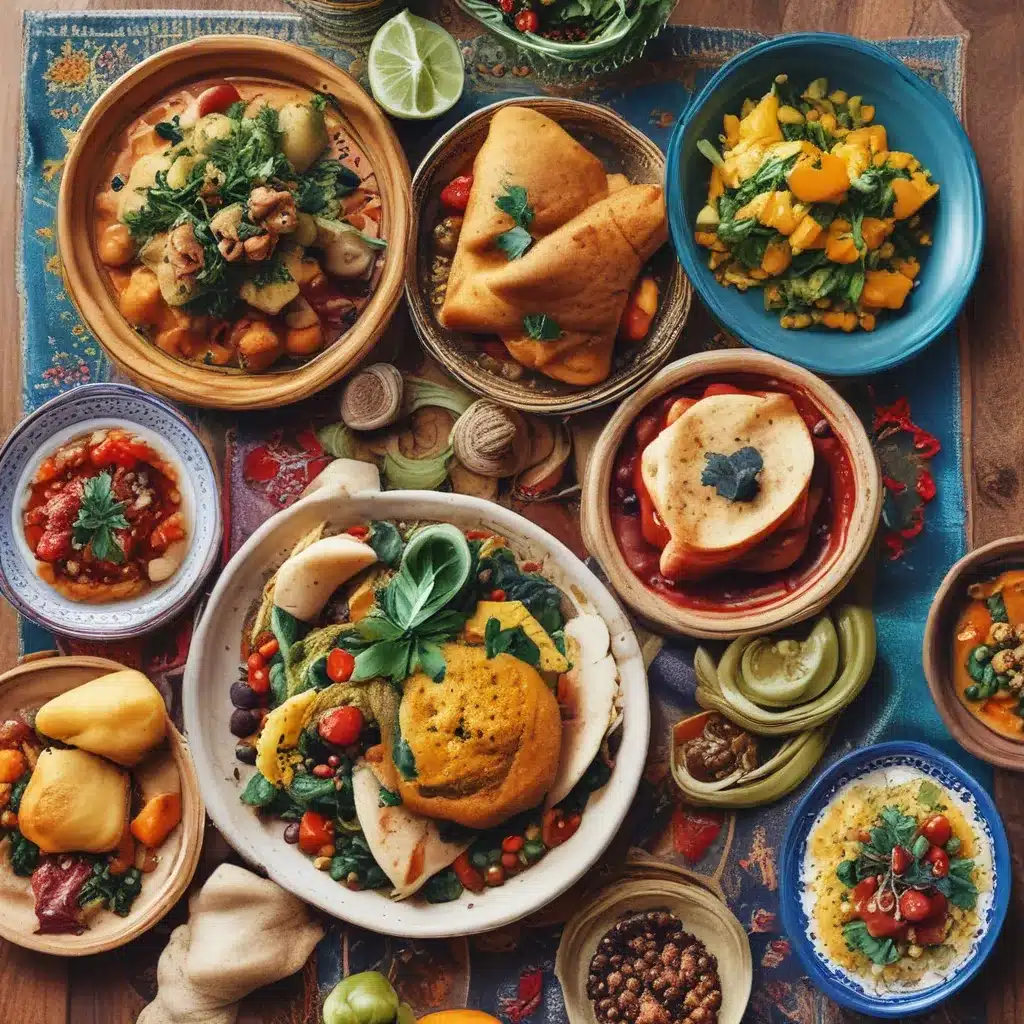
Unlocking the Secrets of Moroccan Cuisine
Have you ever found yourself wandering the aisles of your local grocery store, gazing longingly at the exotic spices and intriguing ingredients, wondering how on earth you could incorporate the bold, mouthwatering flavors of Moroccan cuisine into your everyday meals? Well, my friends, your culinary prayers have been answered.
As a self-proclaimed foodie and Moroccan cuisine enthusiast, I’m here to let you in on a little secret: Moroccan meals don’t have to be intimidating or time-consuming. In fact, with a few key ingredients and some simple techniques, you can transport your taste buds to the vibrant markets of Marrakech right from the comfort of your own kitchen.
Demystifying the Moroccan Pantry
The foundation of Moroccan cooking lies in its spice blends. Names like ras el hanout, harissa, and baharat might sound foreign and daunting, but trust me, once you get acquainted with these flavor powerhouses, your world of culinary possibilities will expand exponentially.
Ras el hanout, for instance, is a complex blend of up to 30 different spices, including warming cinnamon, earthy cumin, and fragrant cardamom. A sprinkle of this magical mixture can instantly elevate dishes from basic to bold. Don’t be intimidated by the long list of ingredients – most grocery stores now carry pre-made ras el hanout blends, making it easy to incorporate this signature Moroccan flavor into your cooking.
Another staple you’ll want to have on hand is harissa, a fiery North African chile paste that adds a delightful heat and depth of flavor to everything from tagines to roasted vegetables. And let’s not forget about baharat, a warm, aromatic spice blend that’s a game-changer in marinades and rubs.
By stocking your pantry with these essential Moroccan spices, you’ll be well on your way to creating authentic-tasting dishes in no time.
Tagines: The Quintessential Moroccan One-Pot Wonder
When it comes to Moroccan cuisine, the tagine is the unsung hero. This traditional earthenware pot with its distinctive cone-shaped lid is not only visually stunning, but it also works its magic, infusing meats, vegetables, and fruits with captivating flavors.
Chicken tagine, for instance, is a classic Moroccan dish that features tender chicken thighs braised in a fragrant broth seasoned with garlic, onions, olives, and the bright, tart notes of preserved lemons or lemon juice. The long, slow cooking process allows the flavors to meld together, creating a symphony of taste in every bite.
But tagines aren’t just for meat – they’re equally adept at showcasing the vibrant colors and textures of vegetable-forward dishes. A Moroccan vegetable tagine might feature a medley of roasted root vegetables, chickpeas, and dried fruit, all simmered in a sauce that’s simultaneously sweet, savory, and spicy.
The best part? Tagines are essentially one-pot wonders, making them the perfect solution for busy weeknights when you want to serve up a delicious, fuss-free meal.
Couscous: The Fluffy Sidekick to Moroccan Meals
No Moroccan feast would be complete without the humble yet versatile couscous. These tiny, pearl-like grains are the perfect canvas for absorbing the bold flavors of the main dish, whether it’s a fragrant tagine or a zesty vegetable stew.
Contrary to popular belief, couscous isn’t as difficult to prepare as you might think. In fact, with a few simple steps, you can have a fluffy, light, and oh-so-satisfying side dish that complements Moroccan meals with ease.
The key is to let the couscous “steam” after it’s been rehydrated, allowing the grains to become light and airy. And don’t be afraid to get creative with your toppings – a sprinkle of toasted nuts, a drizzle of yogurt sauce, or a handful of fresh herbs can take your couscous from mundane to magnificent.
Embracing the Unexpected: Moroccan Flavor Combinations
One of the things I love most about Moroccan cuisine is its willingness to embrace unexpected flavor combinations. Sweet and savory, spicy and cooling – these contrasts are what make Moroccan dishes so captivating and memorable.
Take, for example, the classic Moroccan chicken tagine I mentioned earlier. The marriage of tender chicken, briny olives, and tart preserved lemons or lemon juice creates a harmonious balance that tantalizes the taste buds. And let’s not forget the addition of honey, which lends a subtle sweetness that rounds out the dish.
Or consider the Moroccan vegetable tagine – a vibrant, colorful medley of roasted vegetables, chickpeas, and dried fruit like apricots or raisins. The sweet-and-savory interplay is nothing short of captivating, and it’s a testament to the creativity and bold flavors that define Moroccan cuisine.
Bringing the Flavors of Morocco to Your Table
I know what you’re thinking: “But Moroccan food sounds so complex and intimidating! How on earth can I recreate these authentic flavors at home?”
Fear not, my friends, for I’m here to let you in on a little secret: Moroccan meals don’t have to be a daunting task. With a well-stocked pantry, a few key techniques, and a willingness to experiment, you can easily bring the vibrant, captivating flavors of North Africa to your own kitchen.
So, what are you waiting for? Grab your tagine (or a heavy-bottomed pot, if you don’t have one), stock up on those essential Moroccan spices, and let’s embark on a culinary adventure that will have your taste buds dancing with delight. Head over to elbahia.com to explore our mouthwatering menu and start planning your Moroccan feast today.


